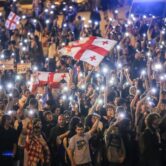(CN) — The leader of Northern Ireland’s Democratic Unionist Party, Jeffrey Donaldson, has agreed to a deal with the U.K. government to return to the divided region’s administration, ending a two-year boycott that had brought power sharing to the brink of collapse.
The announcement sets the stage for the restoration of governance in Northern Ireland, following a stalemate which had grown into an existential crisis for the territory’s peacetime democratic institutions.
At an emergency meeting of the Northern Ireland Assembly earlier this month, politicians on all sides had suggested it could be the final time they met. Yet Donaldson’s decision to push his party — known as the DUP — back into the executive comes following further legislative commitments from the U.K. government, along with a hefty financial package.
"I believe there is now a route to have the devolved government restored," said Donaldson on Tuesday, adding “what we've been able to achieve delivers a good outcome for Northern Ireland because there have been wins to strengthen the union.”
The news was welcomed by Northern Ireland First Minister-designate, Sinn Féin’s Michelle O’Neill, who said: “It is vital there is political stability to address the scale of the crisis across our public services. Let's now focus minds on the job at hand and to the solutions required to support workers and families who want and deserve functioning government."
The plan to re-enter the executive is controversial within the DUP, and threatens to split the unionist movement. A meeting to agree a common party position descended into farce on Monday night, with the apparently chaotic and angry scenes being live-leaked to loyalist campaigner Jamie Bryson.
Donaldson is left walking a tightrope with many favoring the continuation of the boycott rather than working with a nationalist first minister. The ultra-hard-line Traditional Unionist Vote party, which opposes cooperation with Sinn Féin, stands to benefit from the rift. Further splits among unionists may well strengthen Sinn Féin, which campaigns for Irish reunification.
However, signs that the boycott was beginning to reach breaking point were starting to show. Lacking political oversight, civil servants had been left administering the region without the ability to make funding decisions. The result was a real-terms slashing of government wages and expenditure as inflation rose, leaving public services on the brink of collapse.
Public sector workers across Northern Ireland had begun widespread strike action, protesting that their promised wage increases had failed to materialize. Unions warned that the prolonged stalemate was resulting in workers leaving public services such as schools and hospitals, compounding a funding crisis with a staffing one.
The boycott had also left the DUP largely isolated in the Northern Ireland Assembly, with the Ulster Unionist Party joining nationalists in condemning the decision to collapse power sharing. Moderate unionist voters have increasingly turned to the non-sectarian Alliance Party as the DUP has sought to consolidate its base, leaving the party with less reach in the region than it once had.
Donaldson may also have been calculating that his party was unlikely to receive a better deal from London after the U.K.’s upcoming general election, which the Labour Party is expected to win. The governing Conservative Party are much closer with the DUP, who helped them remain in government following the indecisive 2017 general election, and backed the party’s vision for Brexit.
The clincher for the DUP’s agreement appears to be an assurance from the British government that Northern Ireland will not need to follow EU rules, and that goods passing between Northern Ireland and Great Britain will not require any customs checks. However, the deal is yet to be published, leading to rampant speculation across Westminster about its content.
Naturally the lack of information has unnerved some in both Dublin and Brussels, neither of whom were involved in the most recent negotiations. Both the Irish government and the European Union will be determined to ensure that the new deal does not create any new regulatory differences between Northern Ireland and the Irish republic.
At the same time, hard-line anti-EU Conservative parliamentarians will equally be seeking assurances that the deal does not water down the U.K.’s separation from the trading bloc — a move which could threaten to reignite a frozen civil war over Brexit in the Conservative Party.
It is hard to see how both groups could be satisfied with the outcome — which may be why the British government has delayed publication of the agreement, while it works out how best to sell it to the opposing camps. In the meantime, whether this circle can finally be squared remains hanging in the balance.
Many hope that restoring Northern Ireland’s governance will prove to be the last nail in the coffin of Britain’s tortuous exit process from the European Union — a process that British Prime Minister Rishi Sunak has appeared determined to conclude since taking office.
The need to demonstrate unity in an election year may supersede any desire for more factional battles over trade and sovereignty. And neither the EU nor the Irish government wants to be the party prolonging a stalemate that has shaken the credibility of peacetime Northern Ireland.
But while the finish line is in plain sight, not quite all the hurdles have been cleared.
Subscribe to Closing Arguments
Sign up for new weekly newsletter Closing Arguments to get the latest about ongoing trials, major litigation and hot cases and rulings in courthouses around the U.S. and the world.









